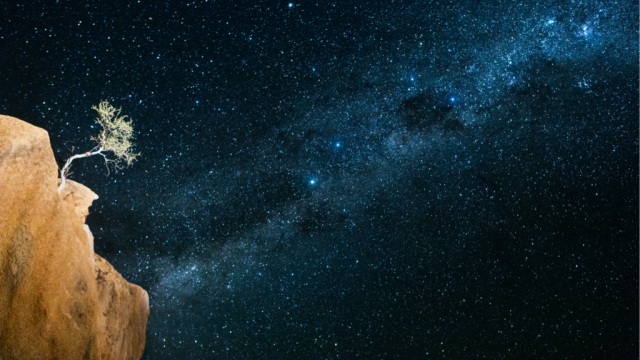Happy 230th Birthday, Enceladus, Our Solar System’s Greatest Hope For Life Beyond Earth
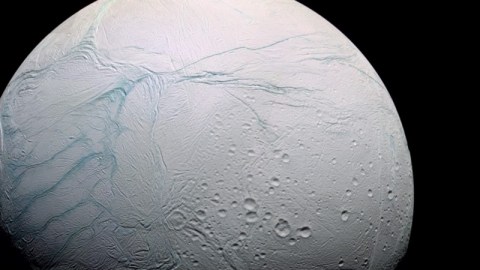
In 1789, William Herschel discovered this unique moon around Saturn. 230 years later, its secrets are more promising than ever.
Today marks the 230th anniversary of the discovery of Enceladus, one of the most unique and puzzling worlds of our Solar System. Its discoverer, William Herschel, had become famous across the world for his serendipitous discovery, back in 1781, of the 7th planet in our Solar System: Uranus. Herschel was catapulted to stardom for this, and was granted anything he wanted to continue his studies by King George of England.
Unsurprisingly, he chose to build what was then the world’s most powerful telescope, which he used to observe the skies as never before. With unsurpassed resolution and light-gathering power, he could see moons and nebulae that were invisible to all previous astronomers. In 1789, he saw a small, white speck around Saturn: its moon Enceladus. Although it remained little more than a speck for 200 years, it’s renowned today as perhaps the most promising location for life beyond Earth in all the Solar System.
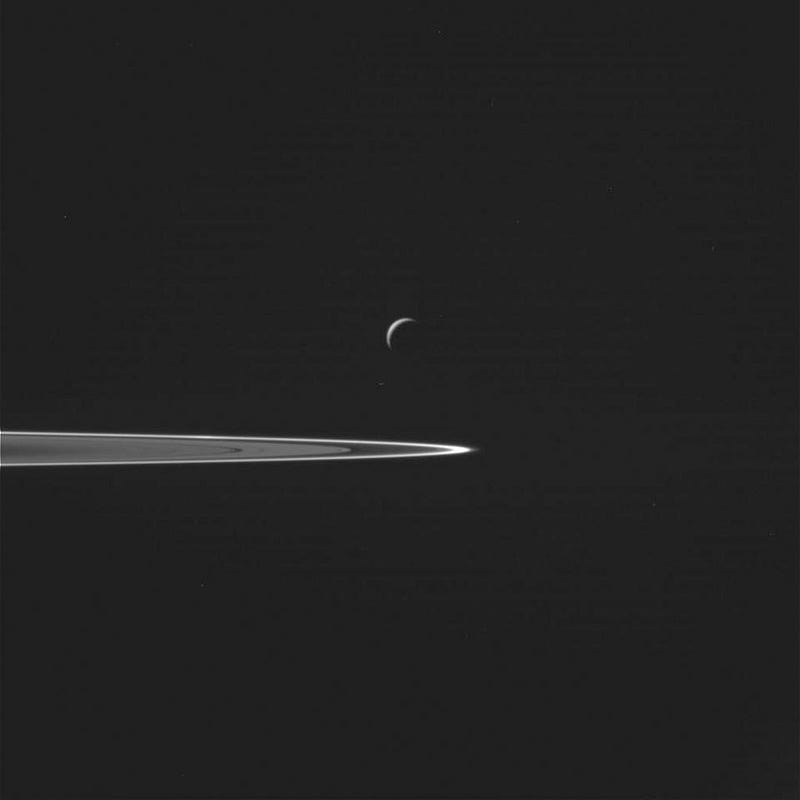
It’s hard to think about life beyond Earth as being likely on a tiny, outer moon of one of the Solar System’s giant worlds. Enceladus, like all of Saturn’s moons, is distant from both Earth and the Sun, and is far colder than even winter in Antarctica.
Enceladus is located some 800 million miles (around 1.3 billion km) from Earth, located relatively far from Saturn: beyond its main rings. It’s quite on the small side as far as major moons go: about 310 miles (500 km) across, or about the size of the second-largest known asteroid: Vesta. It never gets warm on Enceladus, as the maximum temperature on this world never rises above -130 °C (-200 °F).
If this was all you knew about this Saturnian moon, you’d probably never give it a second thought. You’d write it off as just another small, useless moon.
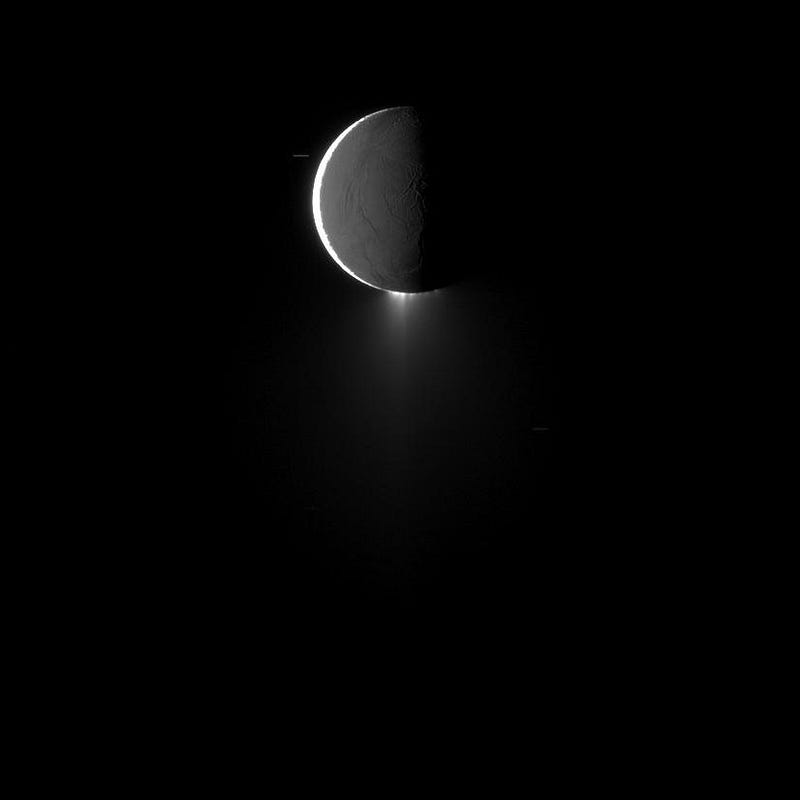
Given that we know of 62 moons around Saturn, and that one of them (Titan) is enormous and has a thick atmosphere with liquid hydrocarbons on its surface, it hardly seems like Enceladus would be the place to look for life. It has no thick atmosphere like Titan; it has no lava-rich volcanoes like Io or cryovolcanoes like Triton. But still, Enceladus might be the most habitable place in our Solar System beyond Earth.
Its ultra-reflective, lifeless surface simply provides cover for a complex, possibly life-rich liquid ocean that begins just ~20 kilometers (12 miles) beneath the icy crust. A series of pale blue stripes cuts across its surface, telling the tale of deep fissures that go down into the interior of the world. But what’s perhaps most remarkable is that we can actually see water-ice being spewed from these fissures into space, extending upwards for hundreds of miles (or kilometers) with every eruption.
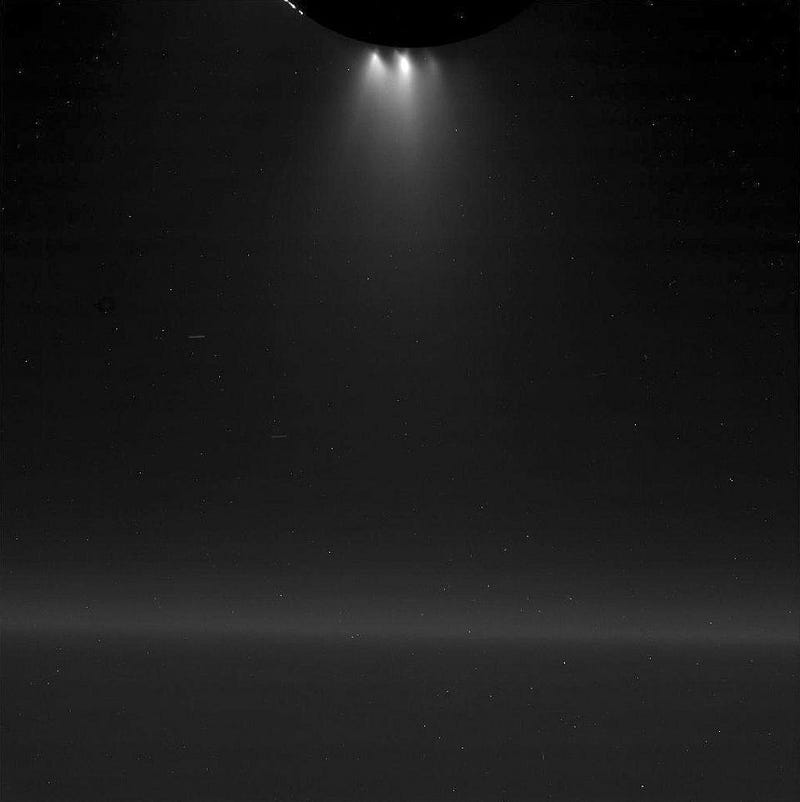
Mythologically, Enceladus has its origin in the form of a giant — the son of Uranus (the sky) and Gaia (the Earth) — who was defeated by Athena when the Gods warred against their predecessors: the Titans. That might seem ironic today, given the small size of the world itself.
However, it was the glare from Saturn’s rings that prevented Enceladus from appearing as anything more than a single speck (or pixel) until the 1980s: 200 years after its first discovery. It was only when we launched our first fly-by missions of the gas giant worlds of the outer Solar System, in the form of Voyager 1 and 2, that we captured our first close-up images of Enceladus. Those first results immediately set off a firestorm of interest in this frozen world, as they revealed a very different orb from the isolated, rocky body that scientists were expecting.
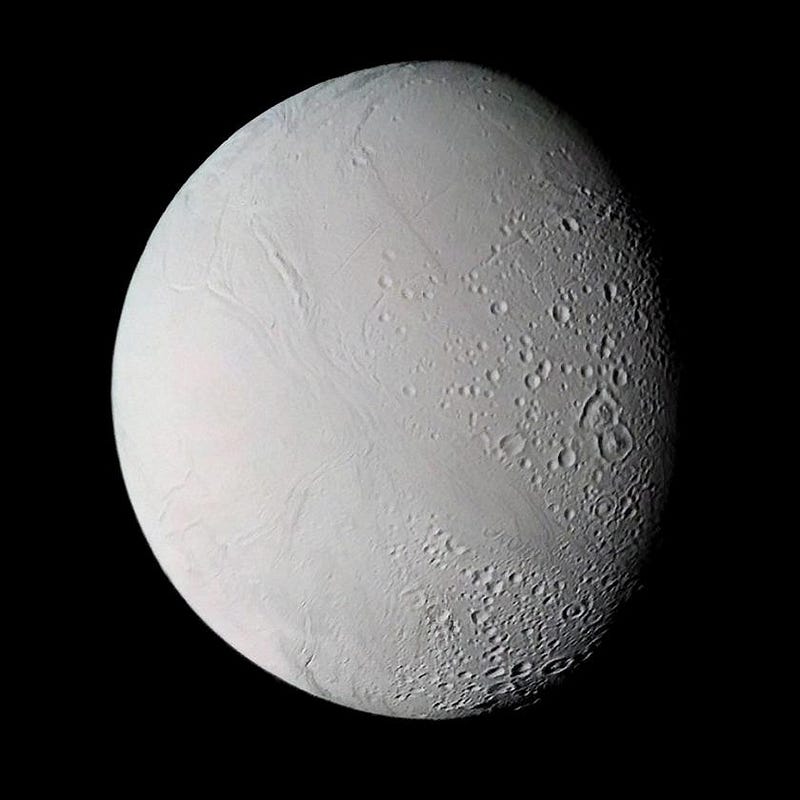
Although there are heavily cratered portions of Enceladus, there are large sections of its surface that are completely smooth. And it’s not just smooth, but it’s also bright: the ices that are on the surface of Enceladus are some of the most reflective surfaces found in the entire Solar System.
This isn’t just hyperbole, but something that’s been affirmed by quantitative observations. Based on every world we’ve ever imaged in the Solar System, one fun fact remains: Enceladus is the most reflective object known in the entire Solar System, with an albedo (which is a scientific measure of reflectivity) of 99%.
The smoothness is also compelling, because the only way you can have a surface this smooth on a world like Enceladus is if it’s actively resurfaced. Much like a zamboni smoothing over a skating rink, the lack of craters on Enceladus is evidence that its icy surface has been refreshed recently.
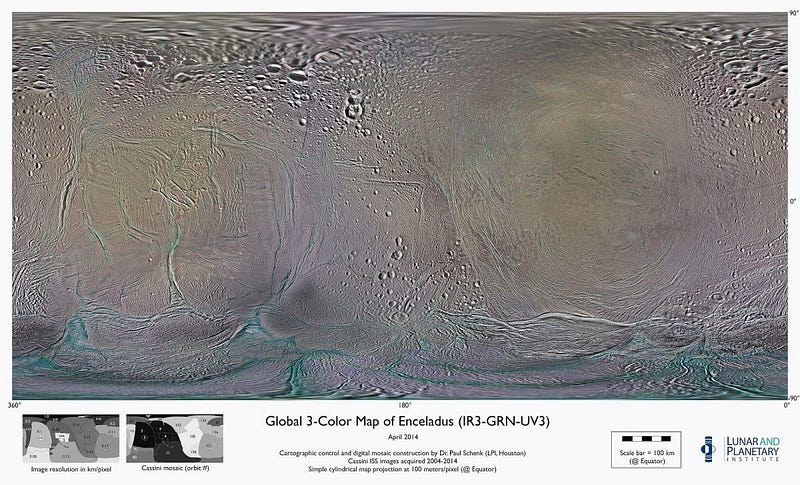
The only viable explanations for a sleek surface such as this are if there was significant tectonic or volcanic activity in recent times for Enceladus. The Cassini mission has been spectacular for understanding what forces drive this natural “space zamboni” on Enceladus, and some of the best evidence is visible in the image above: the regions where the cracks and fissures are deepest are also the smoothest regions of all.
The conclusion is inescapable, it’s the geyser-like activity emerging from these jets that is doing the resurfacing! But that’s not all those geyser-like jets are doing. Saturn doesn’t just have moons and its main rings, but also fainter, outer rings. One of them, the E-ring, just so happens to align with the orbit of Enceladus. In a breathtaking leap, Voyager scientists used the high reflectivity, smooth surface, and active jets on Enceladus to predict that the E-ring was formed by particles emitted from Enceladus’ surface!
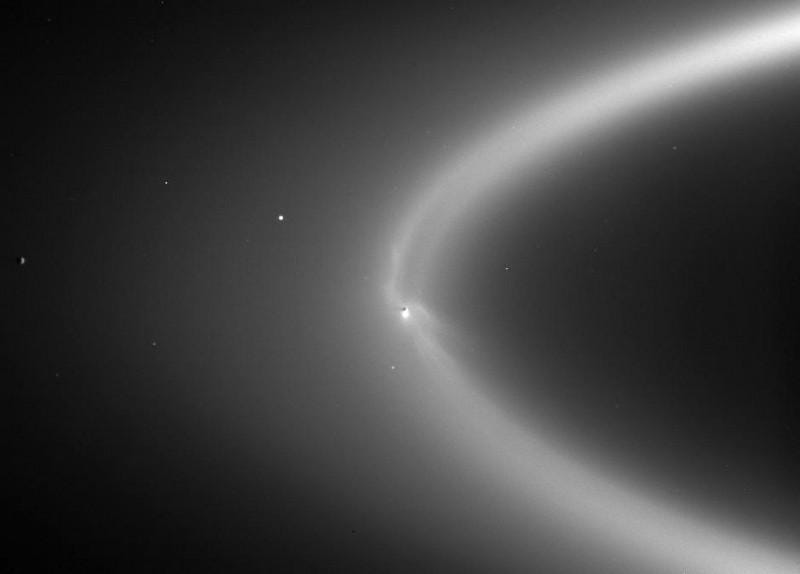
When the Cassini mission reached Saturn back in 2004, just 15 years ago, it resulted in a tremendous renewal of interest in Enceladus. Numerous close fly-bys of Cassini with Enceladus occurred in 2005, 2008, and 2009, bringing this icy moon and its associated E-ring back into prominence. For the first time, scientists were actively gathering data as to the composition of Enceladus’ surface, the E-ring’s makeup, and what was present in Enceladus’ plumes.
The biggest takeaway was that beneath the icy surface of Enceladus, a deep and enormous saltwater ocean had to exist. The tidal forces of Saturn, at the distance of this moon, should be enough to generate heat in the moon’s core, crack open the crust, and enable the release of pressurized liquid. Add in the organic molecules that are known to exist throughout the Solar System, and you have the three key components necessary for life: water, warmth, and the ingredients for life itself.

We fully expect to find amino acids and other molecules that are precursors to life, as chemistry alone will account for that. But the Cassini mission dared us to take the next steps: to look for extraterrestrial life on Enceladus itself, either by drilling down into the subsurface ocean or flying through these geyser-like plumes which erupt into space. If extraterrestrial life is discovered there, the implications boggle the mind.
Yes, there are lots of reasons to hope there’s life on Enceladus, as it would revolutionize the search for intelligent alien life. But it would also redefine how we understand biological processes entirely. Our current picture of the origin of life is solely based on what we’ve observed on Earth. Extremophiles, such as those organisms living on the bottom of the ocean, were once thought to be impossible. Our original definition of the requirements for life processes turned out to be far too restrictive.
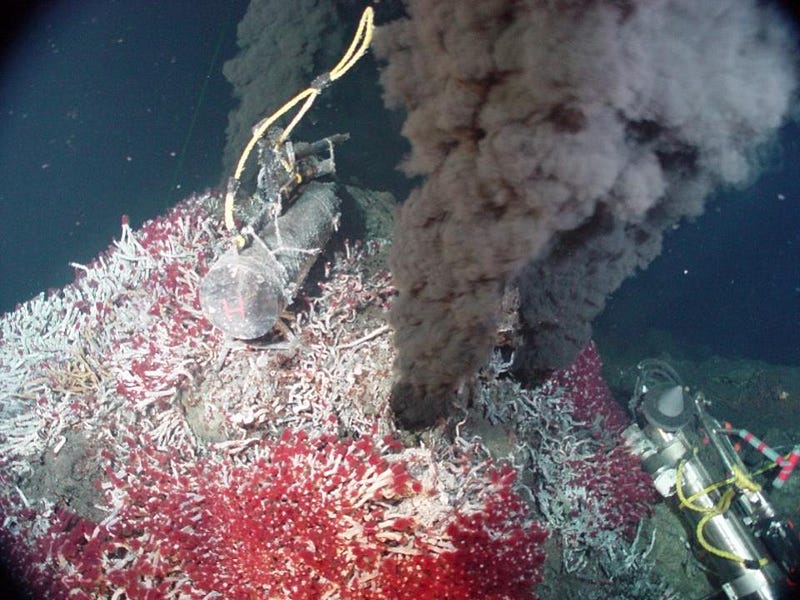
If we were to discover life on Enceladus, it could overthrow what we currently conceive of as the seven basic requirements of life. According to modern thought, all life:
- is made up of cells,
- responds to external stimuli,
- is capable of reproducing,
- passes on its traits to offspring,
- has a metabolism that involves input from the external environment,
- maintains some form of homeostasis,
- and grows and changes over the course of its existence.
For all of what we know of life, however, it might not be so far-fetched to imagine that some form of extraterrestrial creature might not necessarily follow every single one of these requirements. In a vastly different environment with tremendously different conditions than what we find (or have ever found) on Earth, perhaps we’ll discover our current definition of life is far too restrictive.
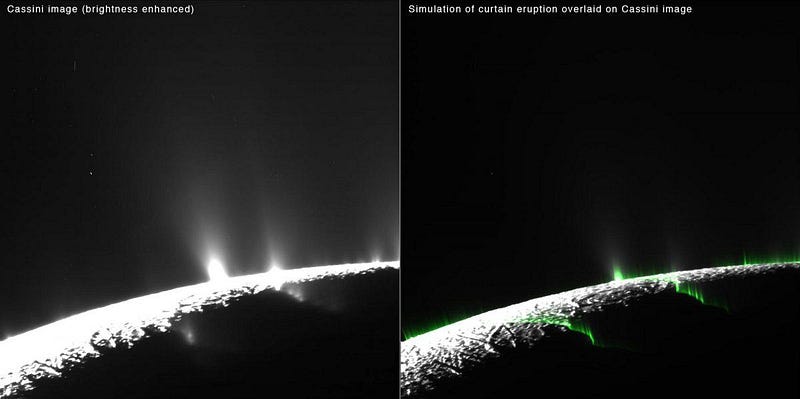
Maybe the briny environment of the oceans of Enceladus have free-floating molecules that reproduce themselves, defying the conventional wisdom that life would need to be cellular in nature. Perhaps homeostasis is only an option, not a requirement, and that an organism that is subject to the variable whims of its environment is eminently possible. Perhaps our imaginations are limited by the structure and function of DNA, and that not all life forms will reproduce or pass on their traits to an offspring.
However creative our human minds may be, we must remember that nature is often stranger than we’re capable of imagining. As scientist Jesse Shanahan once stated,
The basic truth is that we cannot truly know what defines extraterrestrial life until that first discovery is made.
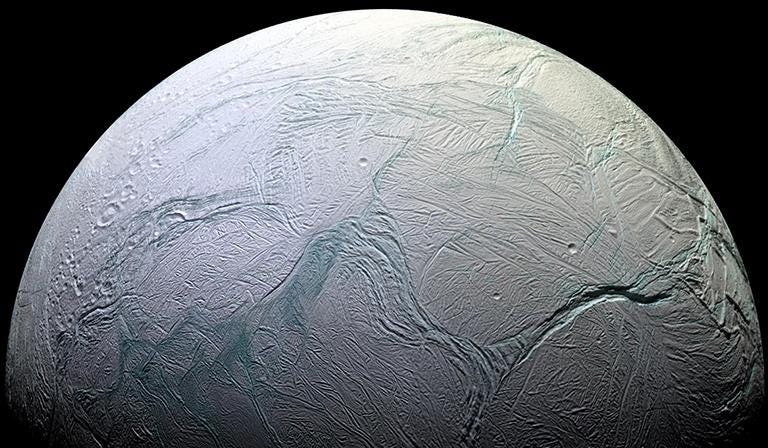
It is still a complete unknown whether Earth is the only world in the Solar System to house any form of life: past or present. Venus and Mars may have been Earth-like for a billion years or more, and life could have arisen there early on. Frozen worlds with subsurface oceans, like Enceladus, Europa, Triton or Pluto, are completely different from Earth’s present environment, but have the same raw ingredients that could potentially lead to life as well.
Are water, energy, and the right molecules all we need for life to arise? Finding even the most basic organisms (or even the precursor components of organisms) anyplace else in the Universe would lead to a scientific revolution. A single discovered cell in the geysers of Enceladus would be the most momentous discovery of the 21st century. With the recent demise of Cassini, on the 230th anniversary of Enceladus’ discovery, the possibility of finding the incredible compels us to go back. May we be bold enough to make it so.
Ethan Siegel is presently recovering from shoulder surgery that occurred on August 13th, and will return with new articles when the healing process allows it, likely at some point in September.
Ethan Siegel is the author of Beyond the Galaxy and Treknology. You can pre-order his third book, currently in development: the Encyclopaedia Cosmologica.




